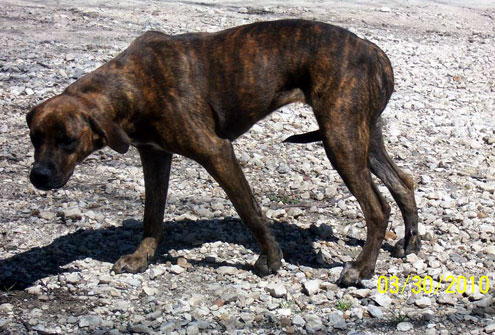You would think that if dogs and cats could control their tails, they would do something useful with them, like pick up something to hold it, or use it to sit up like a tripod on them. However, indications are that the position and action of their tails are emotion-driven through no conscious effort of their own in most cases. Indeed, it is questionable whether they do, in fact, use their tails as a means of communicating with each other.
If we take the time to study the position and action of their tails, we can feel fairly confident that we can take inference from it that the animal is happy, frightened, poised to fight to protect itself or us, or willing to be submissive.

Most of us with cats know that a cat who is twitching just the end of its tail is not a happy cat. We easily recognize that a dog with its entire tail tucked under and between its hind legs is a frightened dog, such as the dog pictured.

This photo was taken by Judy Hanson of an unusually painted brindle female dog she recently found either lost or abandoned on CR 1553 near Leonard. Judy has thus far been unable to locate its owner, but is sure, based on the dogís behavior since it has learned to trust her, that she is a fairly well behaved family dog.
The chart accompanying this column is taken from a ďdog whisperer trainingĒ manual and illustrates the tale tails tell about the emotional state of a dog. Those of us who are prone to trying to rescue animals abandoned along the roadside would do ourselves and the animal a service by learning to read the emotional or characteristic state of an animal with which we are unfamiliar.
Not all lost or abandoned animals are grateful for your attention at first. They are, first of all, confused, disoriented and frightened. A cautious approach is advisable for your own safety. When Fannin County finally has its new animal services center under operation, there will be a safe and humane place to take abandoned and lost animals.
The same is true of the pets belonging to others, even our friendsí pets. Donít assume that just because their pet has seen you before that he or she will remember you if your last visit was your first encounter with it, or if it has been a long time since it has seen you.
Again, reiterating what we have learned about the sensitivity of dogs to our scent and electromagnetic energy, if you are genuinely looking forward to greeting your friendís dog again, it will pick up that signal from you and be happy to see you, too. If you really just donít look forward to being mauled and licked upon your arrival, the dog will likely sense that and will give you the space you deserve.